Question 1.
What will be the unit digit of the squares of the following numbers ?
- (i) 81
- (ii) 272
- (iii) 799
- (iv) 3853
- (v) 1234
- (vi) 26387
- (vii) 52698
- (viii) 99880
- (ix) 12796
- (x) 55555
Solution.
(i) 81
∵1×1
∴ The unit digit of the square of the number 81 will be 1.
(ii) 272
∵2×2
∴ The unit digit of the square of the number 272 will be 4.
(iii) 799
∵9×9
∴ The unit digit of the square of the number 799 will be 1.
(iv) 3853
∵3×3
∴ The unit digit of the square of the number 3853 will be 9
(v) 1234
∵4×4
∴ The unit digit of the square of the number 1234 will be 6.
(vi) 26387
∵7×7
∴ The unit digit of the square of the number 26387 will be 9.
(vii) 52698
∵8×8
∴ The unit digit of the square of the number 52698 will be 4.
(viii) 99880
∵0×0
∴ The unit digit of the square of the number 99880 will be 0.
(ix) 12796
∵6×6
∴ The unit digit of the square of the number 12796 will be 6.
(x) 55555
∵5×5
∴ The unit digit of the square of the number 55555 will be 5.
Question 2.
The following numbers are obviously not perfect squares. Give reason.
- (i) 1057
- (ii) 23453
- (iii) 7928
- (iv) 222222
- (v) 64000
- (vi) 89722
- (vii) 222000
- (viii) 505050.
Solution.
(i) 1057
The number 1057 is not a perfect square because it ends with 7 at unit’s place whereas the square numbers end with 0, 1, 4, 5, 6 or 9 at unit’s place.
(ii) 23453
The number 23453 is not a perfect square because it ends with 3 at unit’s place whereas the square numbers end with 0, 1, 4, 5, 6 or 9 at unit’s place.
(iii) 7928
The number 7928 is not a perfect square because it ends with 8 at unit’s place whereas the square numbers end with 0, 1, 4, 5, 6 or 9 at unit’s place.
(iv) 222222
The number 222222 is not a perfect square because it ends with 2 at unit’s place whereas the Square numbers end with 0, 1, 4, 5, 6 or 9 at unit’s place.
(v) 64000
The number 64000 is not a square number because it has 3 (an odd number of) zeros at the end whereas the number of zeros at the end of a square number ending with zeros is always even.
(vi) 89722
The number 89722 is not a square number because it ends in 2 at unit’s place whereas the square numbers end with 0, 1, 4, 5, 6 or 9 at unit’s place.
(vii) 222000
The number 222000 is not a square number because it has 3 (an odd number of) zeros at the end whereas the number of zeros at the end of a square number ending with zeros is always even.
(viii) 505050
The number 505050 is not a square number because it has 1 (an odd number of) zeros at the end whereas the number of zeros at the end of a square number ending with zeros is always even.
Question 3.
The squares of which of the following would be odd numbers ?
- (i) 431
- (ii) 2826
- (iii) 7779
- (v) 82004.
Solution.
(i) 431
∵ 431 is an odd number
∴ Its square will also be an odd number.
(ii) 2826
∵ 2826 is an even number
∴ Its square will not be an odd number.
(iii) 7779
∵7779 is an odd number
∴ Its square will be an odd number.
(iv) 82004
∵ 82004 is an even number
∴ Its square will not be an odd number.
Question 4.
Observe the following pattern and find the missing digits:
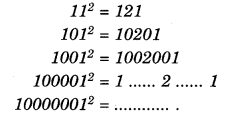
Solution.

Question 5.
Observe the following pattern and supply the missing numbers:
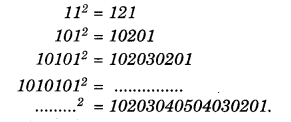
Solution.

Question 6.
Using the given pattern, find the missing numbers:
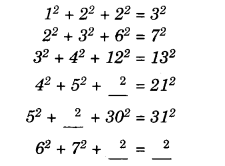
Solution.

Question 7.
Without adding, find the sum:
- (i) 1 + 3 + 5+7 + 9
- (ii) 1 + 3 + 5 + 7 + 9 + 11 + 13 + 15 +17 + 19
- (iii) 1+3 + 5 + 7 + 9 + 11 + 13 + 15 + 17 + 19 + 21 +23.
Solution

Question 8.
(i) Express 49 as the sum of 7 odd numbers.
(ii) Express 121 as the sum of 11 odd numbers.
Solution.
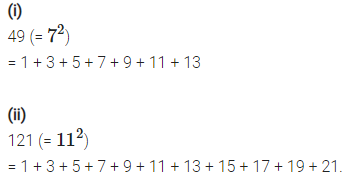
Question 9.
How many numbers lie between squares of the following numbers ?
- (i) 12 and 13
- (ii) 25 and 26
- (iii) 99 and 100.
Solution.
(i) 12 and 13
Here, n = 12
∴ 2n = 2 x 12 = 24
So, 24 numbers lie between squares of i the numbers 12 and 13.
(ii) 25 and 26
Here, n = 25
∴ 2n = 2 x 25 = 50
So, 50 numbers lie between squares of the numbers 25 and 26.
(iii) 99 and 100
Here, n = 99
∴ 2n = 2 x 99 = 198
So, 198 numbers lie between squares of of the numbers 99 and 100.
Chapter 6 Squares and Square Roots Ex 6.2
Question 1.
Find the square of the following numbers:
- (i) 32
- (ii) 35
- (iii) 86
- (iv) 93
- (v) 71
- (vi) 46
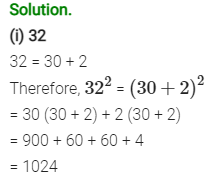
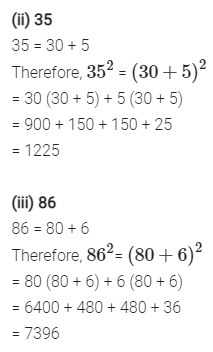
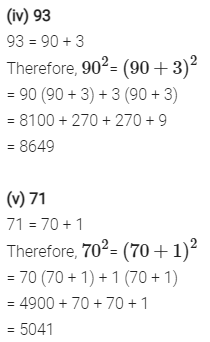
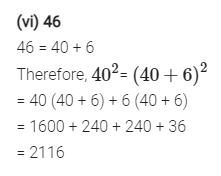
Question 2.
Write a Pythagorean triplet whose one number is
- (i) 6
- (ii) 14
- (iii) 16
- (iv) 18
Solution.
(i) 6
Let 2m = 6
⇒ m=6/2=3

(ii) 14
Let 2m = 14
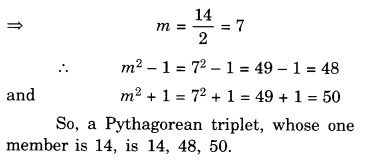
(iii) 16
Let 2m = 16
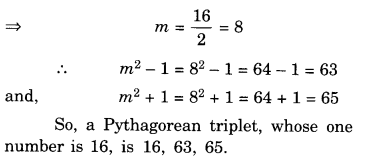
(iv) 18
Let 2m = 18

Chapter 6 Squares and Square Roots Ex 6.3
Question 1.
What could be the possible ‘one’s’ digits of the square root of each of the following numbers ?
- (i) 9801
- (ii) 99856
- (iii) 998001
- (iv) 657666025.
Solution.
(i) 9801
∵ 1 x 1 = 1 and 9 x 9 = 81
∵The possible one’s digit of the square root of the number 9801 could be 1 or 9.
(ii) 99856
∵ 4 x 4 = 16 and 6 x 6 = 36
∵ The possible one’s digit of the square root of the number 99856 could be 4 or 6.
(iii) 998001
∵1×1 = 1 and 9 x 9 = 81
∵The possible one’s digit of the square root of the number 998001 could be 1 or 9.
(iv) 657666025
∵5 x 5 = 25
∵The possible one’s digit of the square root of the number 657666025 could be 5.
Question 2.
Without doing any calculation, find the numbers which are surely not perfect squares.
- (i) 153
- (ii) 257
- (iii) 408
Solution.
(i) 153
The number 153 is surely not a perfect square because it ends in 3 whereas the square numbers end with 0, 1, 4, 5, 6 or 9.
(ii) 257
The number 257 is surely not a perfect square because it ends in 7 whereas the square numbers end with 0, 1, 4, 5, 6 or 9.
(iii) 408
The number 408 is surely not a perfect square because it ends in 8 whereas the square numbers end with 0, 1, 4, 5, 6 or 9.
(iv) 441
The number may be a perfect square as the square numbers end wTith 0, 1, 4, 5, 6 or 9.
Question 3.
Find the square roots of 100 and 169 by the method of repeated subtraction.
Solution.
(i) 100
- 100 – 1 = 99
- 99 – 3 = 96
- 96 – 5 = 91
- 91 – 7 = 84
- 84 – 9 = 75
- 75 – 11 = 64
- 64 – 13 = 51
- 51 – 15 = 36
- 36 – 17 = 19
- 19 – 19 = 0
Since from 100, we subtracted successive odd numbers starting from 1 and obtained 0 at the 10th step, therefore,
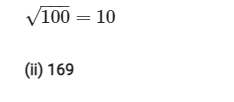
- 169 – 1 = 168
- 168 – 3 = 165
- 165 – 5 = 160
- 160 – 7 = 153
- 153 – 9 = 144
- 144-11 = 133
- 133 – 13 = 120
- 120 – 15 = 105
- 105 – 17 = 88
- 88 – 19 = 69
- 69 – 21 = 48
- 48 – 23 = 25
- 25 – 25 = 0
Since rom 169, we subtracted successive odd numbers starting from 1 and obtained 0 at the 13th step, therefore,

Question 4.
Find the square roots of the following numbers by the Prime Factorisation Method:
- (i) 729
- (ii) 400
- (iii) 1764
- (iv) 4095
- (v) 7744
- (vi) 9604
- (vii) 5929
- (viii) 9216
- (ix) 529
- (x) 8100
Solution.
(i) 729
The prime factorisation of 729 is
729 = 3 x 3 x 3 x 3 x 3 x 3.
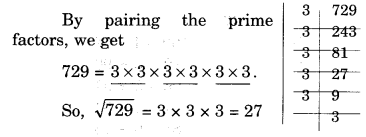
(ii) 400
The prime factorisation of 400 is
400 = 2 x 2 x 2 x 2 x 5 x 5.
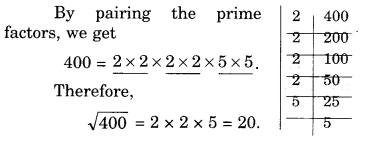
(iii) 1764
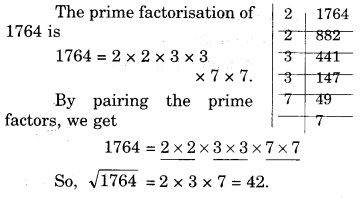
(iv) 4096
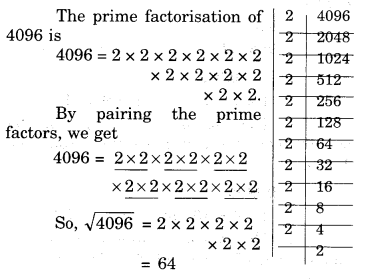
(v) 7744
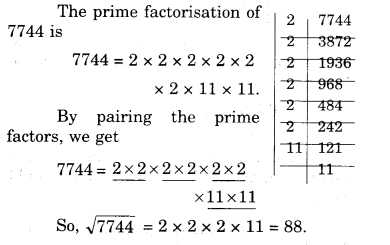
(vi) 9604
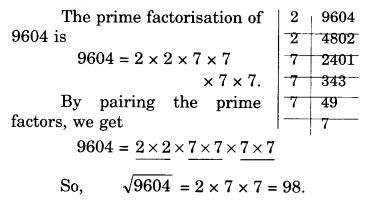
(vii) 5929
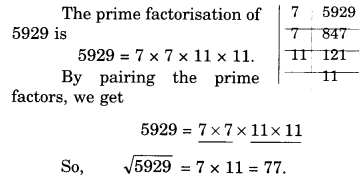
(viii) 9216
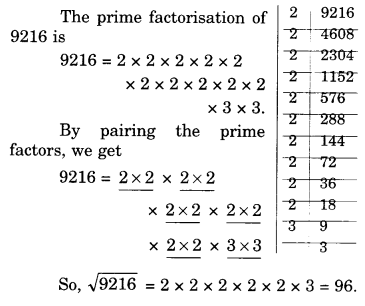
(ix) 529
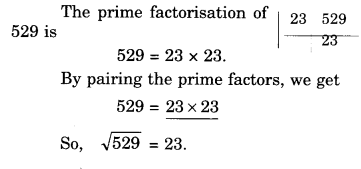
(x) 8100
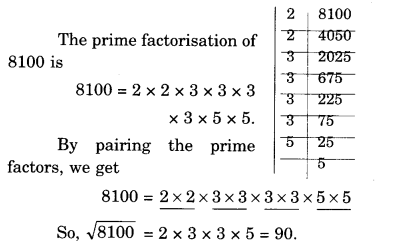
Question 5.
For each of the following numbers, find the smallest whole number by which it should be multiplied so as to get a perfect square number. Also find the square root of the square number so obtained.
- (i) 252
- (ii) 180
- (iii) 1008
- (iv) 2028
- (v) 1458
- (vi) 768
Solution.
(i) 252
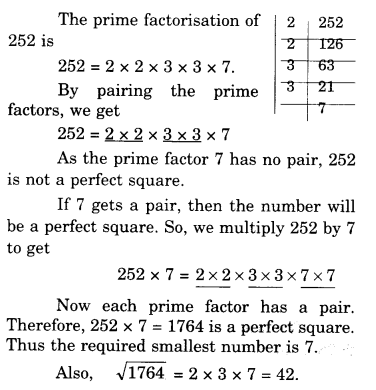
(ii) 180
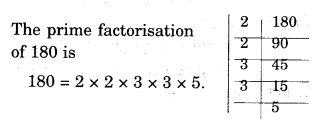

(iii) 1008

(iv) 2028


(v) 1458

(vi) 768


Question 6.
For each of the following numbers, find the smallest whole number by which it should be divided so as to get a perfect square. Also find the square root of the square number so obtained.
- (i) 252
- (ii) 2925
- (iii) 396
- (iv) 2645
- (v) 2800
- (vi) 1620
Solution.
(i) 252

(ii) 2925

(iii) 396

(iv) 2645

(v) 2800


(vi) 1620

Question 7.
The students of Class VIII of a school donated? 2401 in all, for Prime Minister’s National Relief Fund. Each student donated as rr’iny rupees as the number of students in the class. Find the number of students in the class.
Solution.
Let the number of students in the class be x.


Question 8.
2025 plants are to be planted in a garden in such a way that each row contains as many plants as the number of rows. Find the number of rows and the number of plants in each row.
Solution.
Let the number of rows be x.
Then, number of plants in each row = x.

Question 9.
Find the smallest square number that is divisible by each of the numbers 4, 9 and 10.
Solution.

In order to get a perfect square, each factor of 180 must be paired. So, we need to make pair of 5.
Therefore, 180 should be multiplied by 5.
Hence, the required smallest square number is 180 x 5 = 900.
Question 10.
Find the smallest square number that is divisible by each of the numbers 8, 15 and 20.
Solution.


Chapter 6 Squares and Square Roots Ex 6.4
Question 1.
Find the square root of each of the following numbers by Division method:
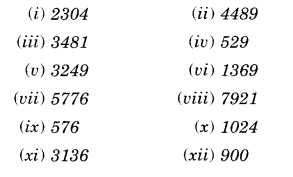
Solution.
(i) 2304
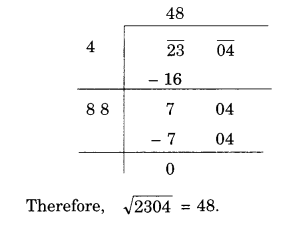
(ii) 4489
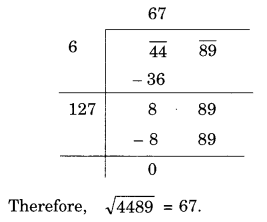
(iii) 3481
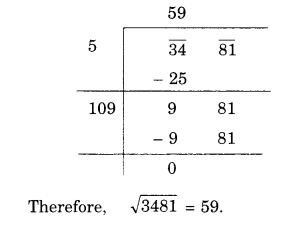
(iv) 529
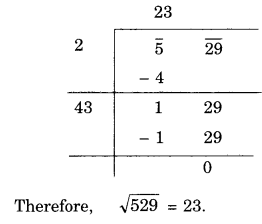
(v) 3249
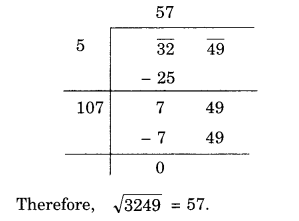
(vi) 1369
(vii) 5776
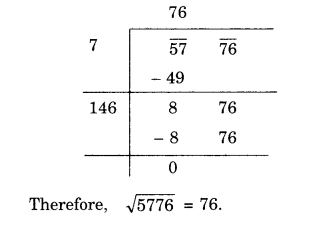
(viii) 7921
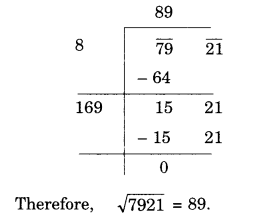
(ix) 576
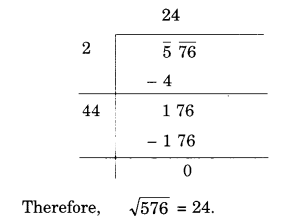
(x) 1024
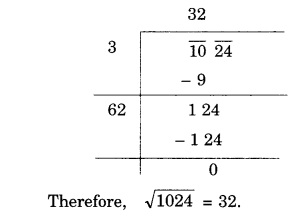
(xi) 3136
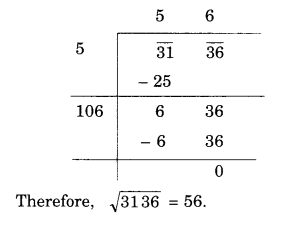
(xii) 900
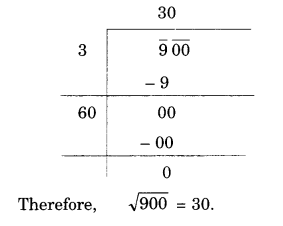
Question 2.
Find the number of digits in the square root of each of the following numbers (without any calculation):
- (i) 64
- (ii) 144
- (iii) 4489
- (iv) 27225
- (v) 390625.
Solution.
(i) 64
Number (n) of digits in 64 = 2 which is even.
∴ Number of digits in the square root of 64 n/2=2/2=1
(ii) 144
Number (n) of digits in 144 = 3 which is
∴ Number of digits in the square root of 144 n+1/2=3+1/2=4/2=2
(iii) 4489
Number (n) of digits in 4489 = 4 which is even.
∴ Number of digits in the square root of 4489 n/2=4/2=2
(iv) 27225
Number (n) of digits in 27225 = 5 which is odd.
∴ Number of digits in the square root of 27225 n+1/2=5+1/2=6/2=3
(v) 390625
Number (n) of digits in 390625 = 6 which is even.
∴ Number of digits in the square root of 390625 n/2=6/2=3
Question 3.
Find the square root of the following decimal numbers:
- (i) 2.56
- (ii) 7.29
- (iii) 51.84
- (iv) 42.25
- (v) 31.36
Solution.
(i) 2.56
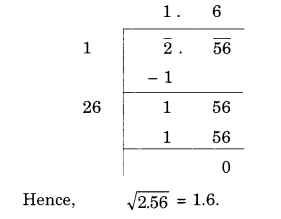
(ii) 7.29
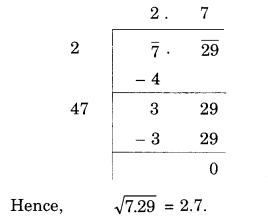
(iii) 51.84

(iv) 42.25
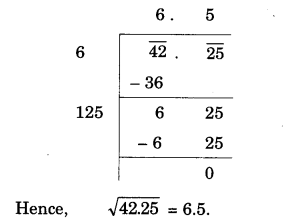
(v) 31.36
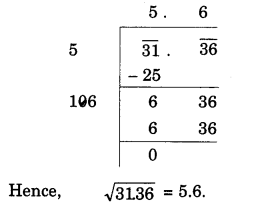
Question 4.
Find the least number which must be subtracted from each of the following numbers so as to get a perfect square. Also find the square root of the perfect square so obtained.
- (i) 402
- (ii) 1989
- (iii) 3250
- (iv) 825
- (v) 4000
Solution.
(i)402
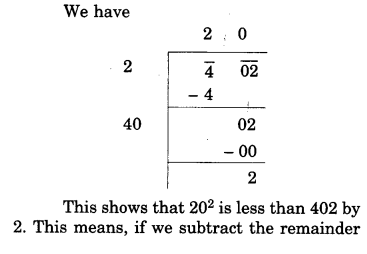

(ii) 1989
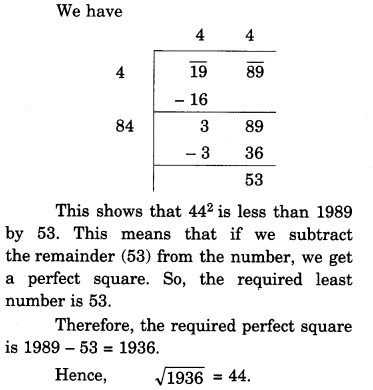
(iii) 3250
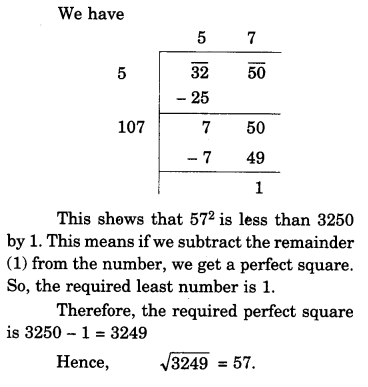
(iv) 825
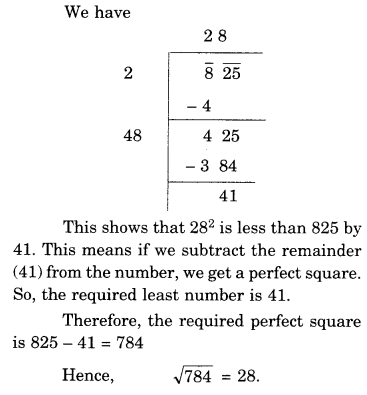
(v) 4000
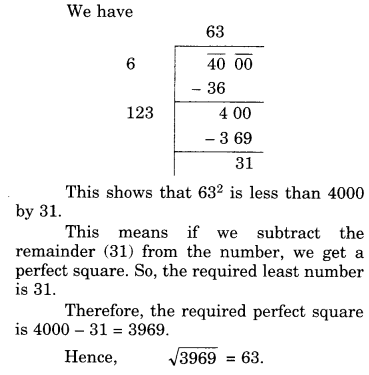
Question 5.
Find the least number which must be added to each of the following numbers so as to get a perfect square. Also find the square root of the perfect square so obtained.
- (i) 525
- (ii) 1750
- (iii) 252
- (iv) 1825
- (v) 6412
Solution.
(i) 525
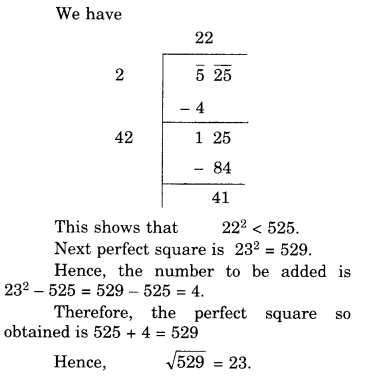
(ii) 1750
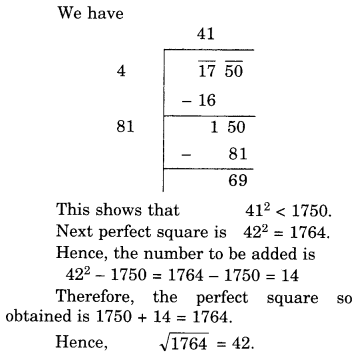
(iii) 252
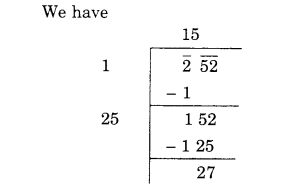
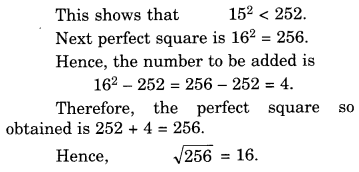
(iv) 1825

(v) 6412
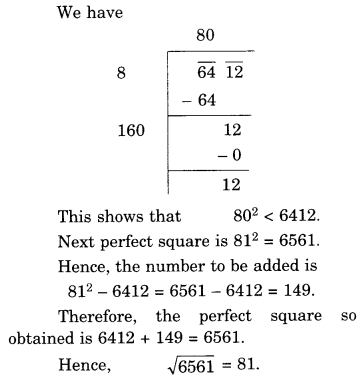
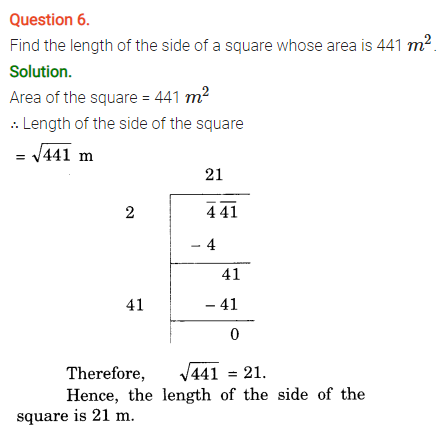
Question 7.
In a right triangle ABC, ∠B = 90°.
(a) If AB = 6 cm, BC = 8 cm, find AC
(b) If AC 13 cm, BC = 5 cm, find AB.
Solution.
(a) In the right triangle ABC,
∠B = 90°
Given
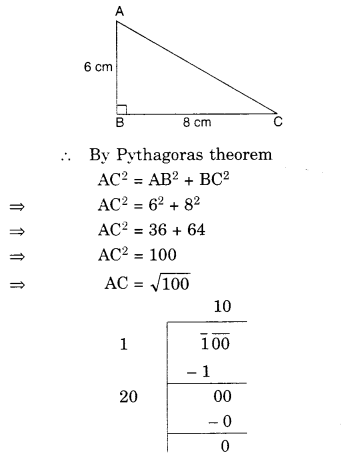
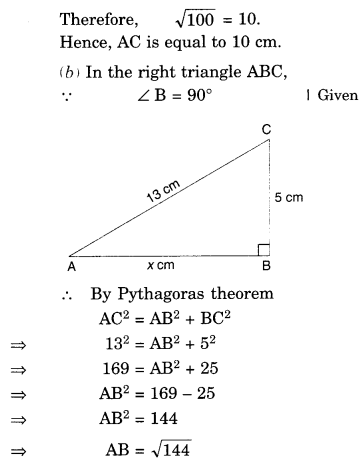
Question 8.
A gardener has 1000 plants. He wants to plant these in such a way that the number of rows and the number of columns remain same. Find the minimum number of plants he needs more for this.
Solution.
Let the number of rows be x.
Then the number of columns is x.

Question 9.
There are 500 children in a school. For a P.T. drill they have to stand in such a manner that the number of rows is equal to number of columns. How many children would be left out in this arrangement?
Solution.
Let the number of rows be x.
Then the number of columns is x.
